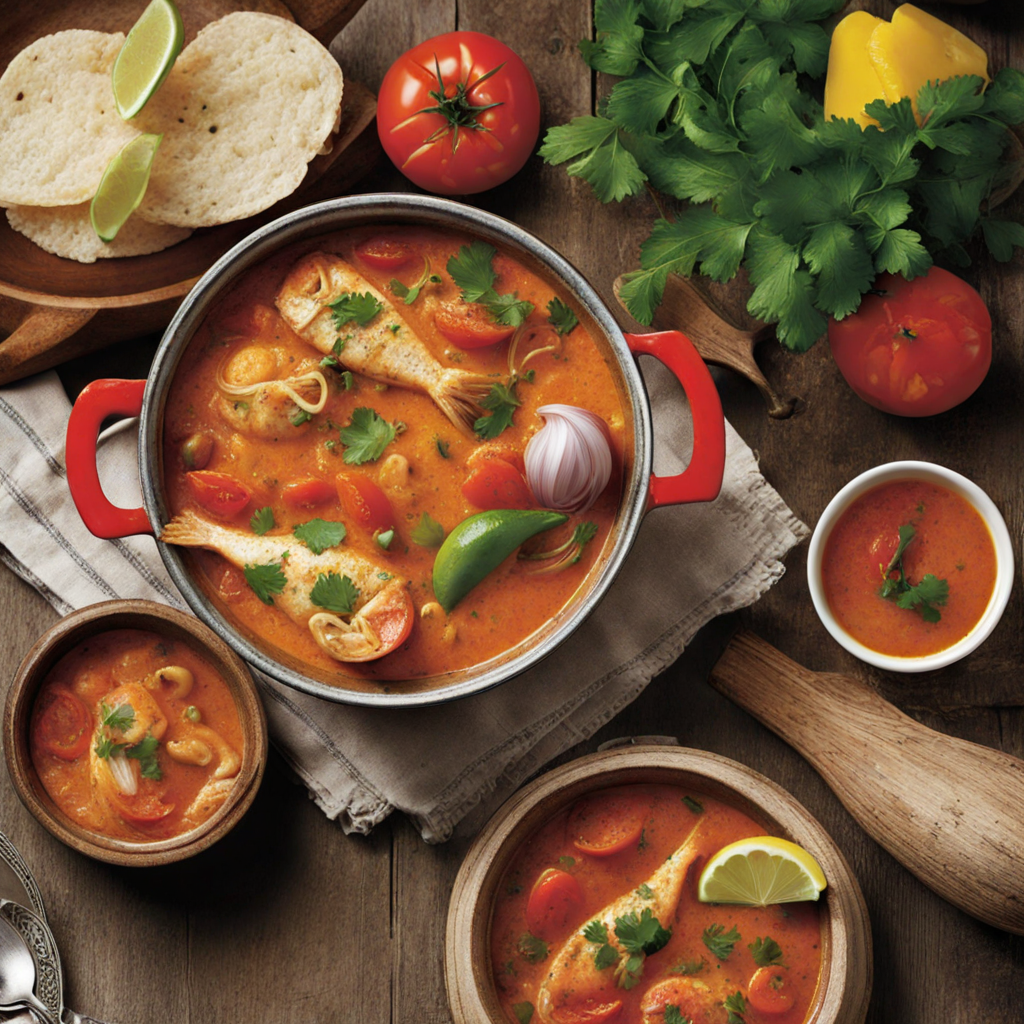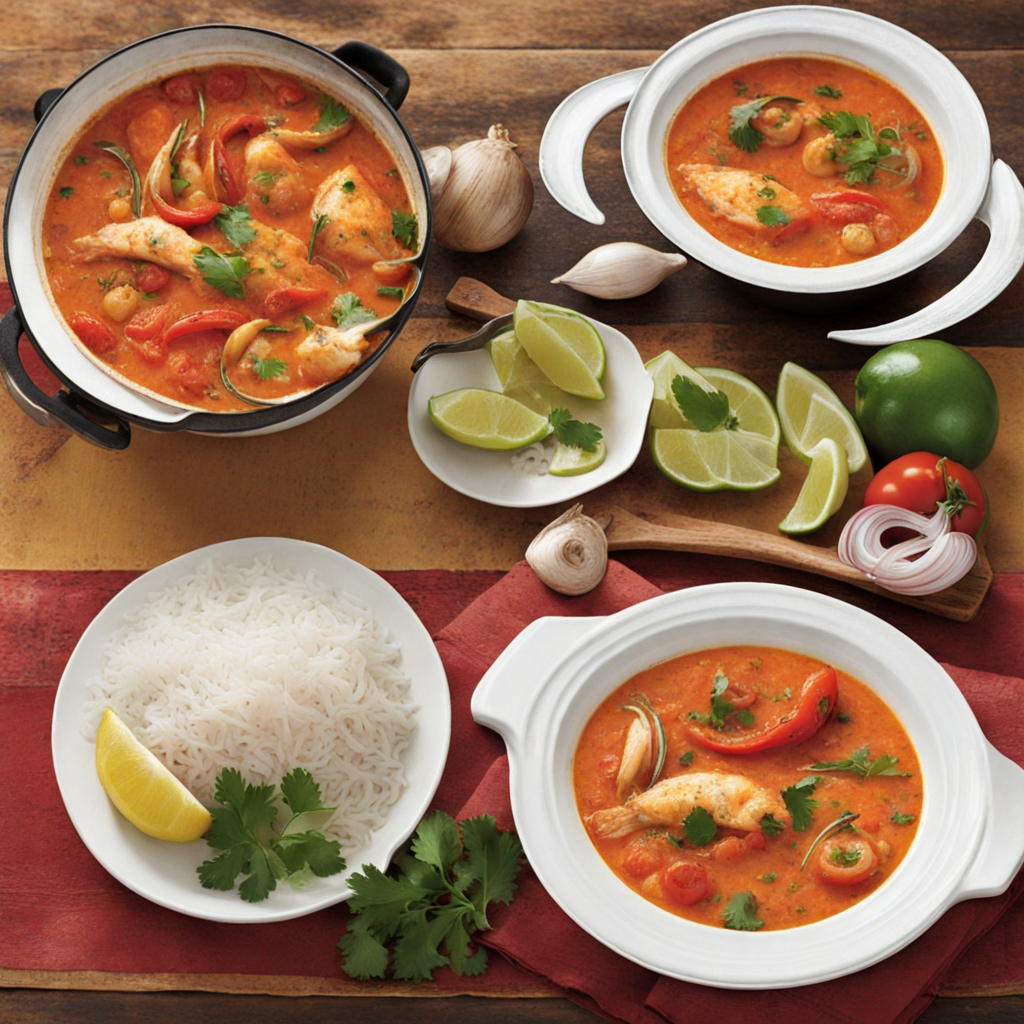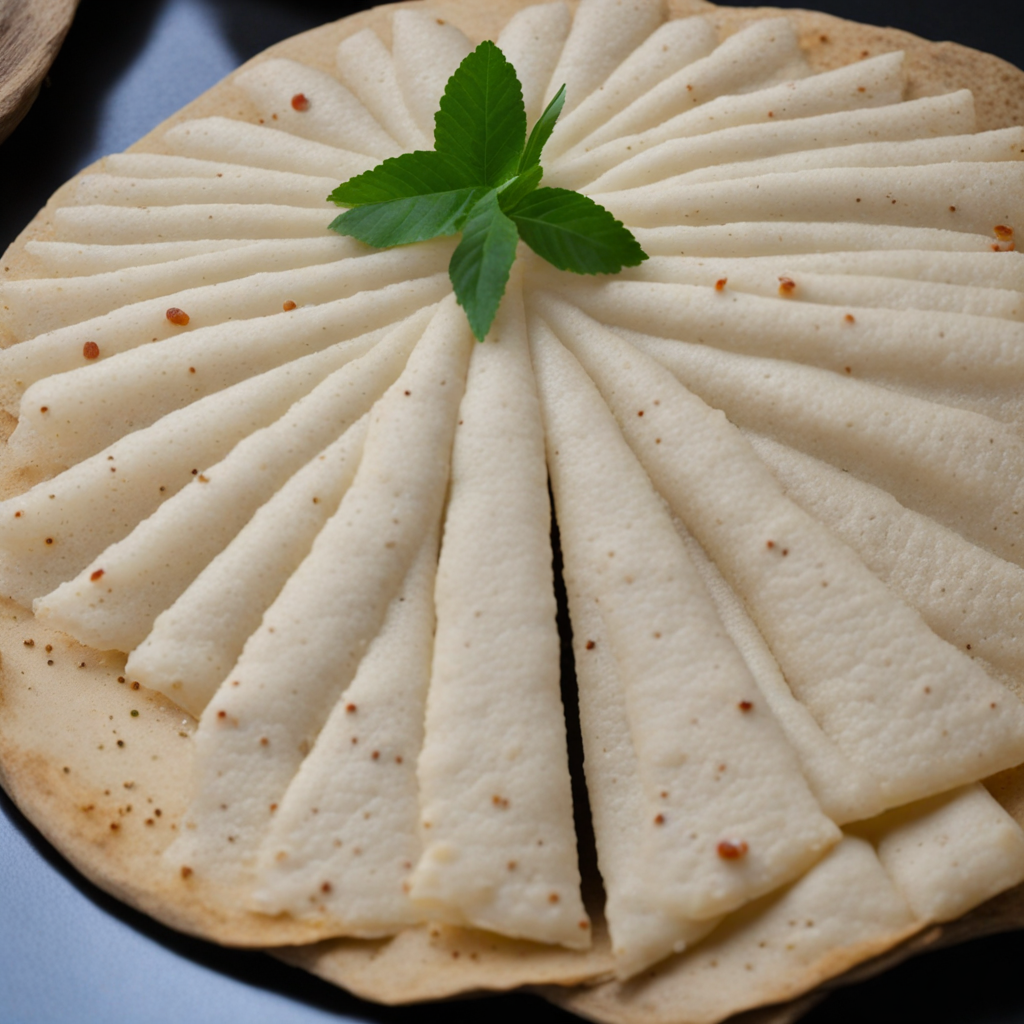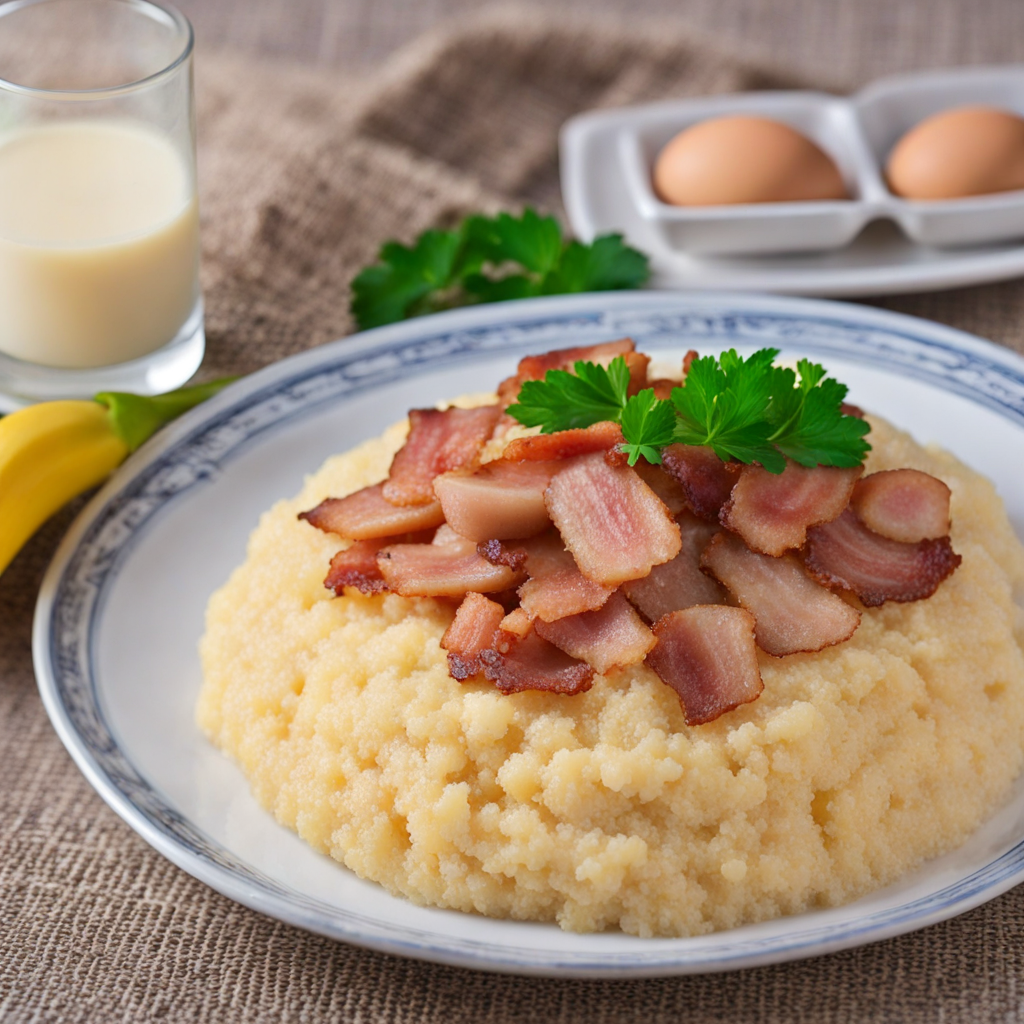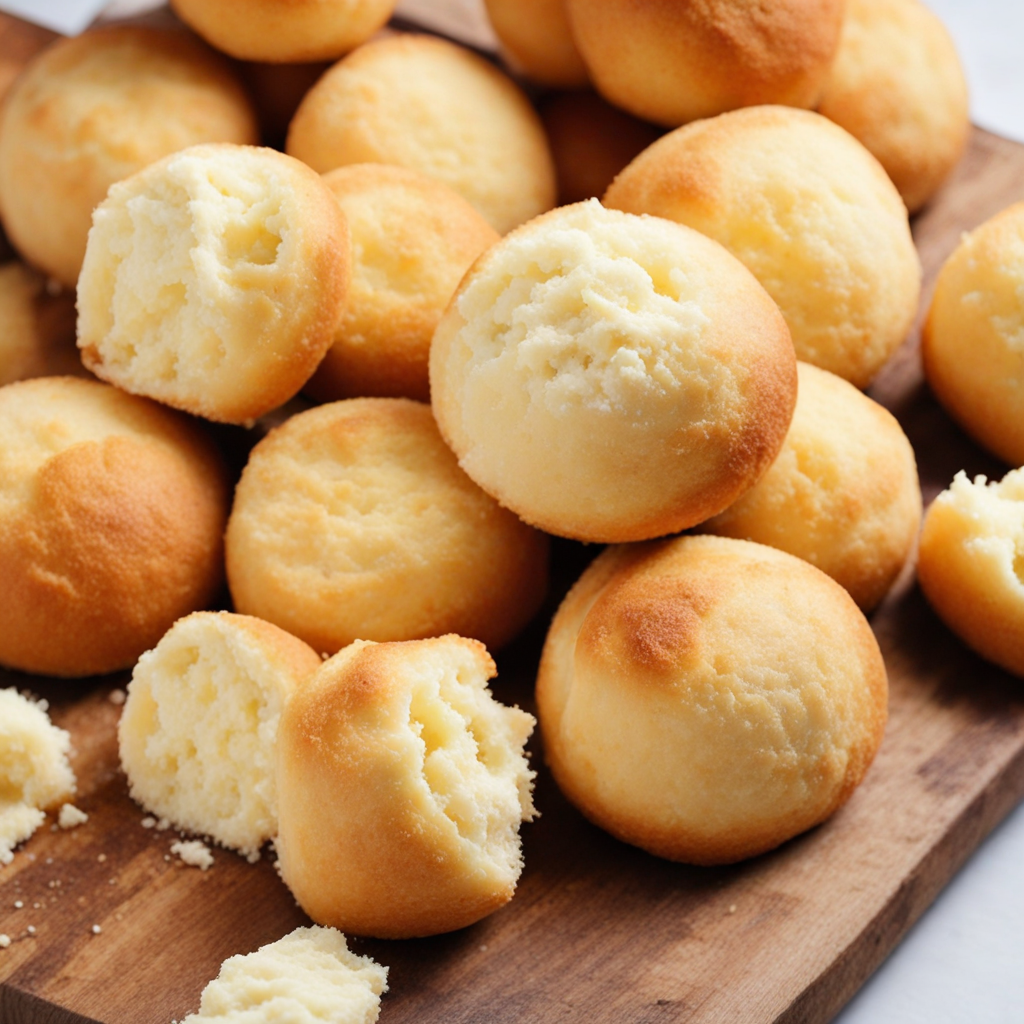Moqueca
Moqueca is a traditional Brazilian dish that embodies the vibrant flavors and culinary heritage of the coastal regions, particularly Bahia and Espírito Santo. This hearty stew is primarily made with fresh fish, shrimp, or a mix of seafood, marinated with lime juice, garlic, and onions, allowing the proteins to absorb a medley of zesty flavors. The dish is then simmered in a rich broth created from coconut milk, palm oil, and a variety of spices, including coriander and cumin. The use of palm oil not only adds a distinct taste but also gives the dish its characteristic golden hue, making it visually appealing as well as delicious. Accompanying the seafood are typically bell peppers, tomatoes, and sometimes onions, which enhance the dish’s texture and add a burst of color. These ingredients are often layered in a clay pot, which is how moqueca is traditionally prepared, allowing all the components to meld together beautifully. The result is a fragrant and flavorful meal that captures the essence of Brazilian cuisine, showcasing both the bounty of the sea and the lushness of tropical ingredients. Each bite is a delightful combination of the tender seafood with the creamy coconut and the vibrant spices, creating a harmonious balance that is both comforting and exciting. Moqueca is often served with a side of fluffy white rice and sometimes farofa, a toasted cassava flour mixture, which adds crunch and depth to the dish. The experience of enjoying moqueca is not just about taste; it’s also about the warmth and hospitality of Brazilian culture, as it is often shared among family and friends during gatherings. For those looking to explore new culinary horizons, moqueca offers a delicious journey into the heart of Brazilian flavors that is sure to awaken the senses and leave a lasting impression.
How It Became This Dish
The Rich History of Moqueca: Brazil’s Culinary Treasure Moqueca is more than just a dish; it is a vibrant tapestry woven from the threads of Brazil’s diverse cultural heritage. This traditional seafood stew, celebrated for its rich flavors and colorful presentation, traces its origins back to the indigenous peoples of Brazil, particularly the Tupinambá tribe, who inhabited the coastal regions long before European contact. The dish has evolved over centuries, influenced by the African, Portuguese, and indigenous culinary traditions, making it a symbol of Brazil's multifaceted identity. #### Origins The roots of moqueca can be traced to the indigenous practices of cooking fish and seafood. The Tupinambá utilized a method of cooking known as "moquém," which involved wrapping fish in leaves and cooking them over hot coals. This technique, while simple, allowed the natural flavors of the fish to shine through, augmented by the use of local herbs and spices. When the Portuguese arrived in the 16th century, they encountered these indigenous practices and began to integrate them into their own cooking. The colonizers introduced new ingredients, such as onions, garlic, tomatoes, and palm oil, which would eventually become staples in the modern interpretation of moqueca. The early fusion of these culinary traditions laid the groundwork for what would become one of Brazil’s most iconic dishes. #### The African Influence As Brazil's economy expanded, so did its reliance on enslaved African labor, particularly from the West African region. Enslaved Africans brought with them their own culinary traditions and ingredients, including the use of dendê oil (palm oil), which became a defining characteristic of moqueca. This ingredient not only adds a distinctive flavor but also a vibrant golden hue that makes the dish visually appealing. The African influence is particularly notable in the state of Bahia, where moqueca became a staple in the local cuisine. The Afro-Brazilian culture that flourished in Bahia during the colonial period infused the dish with new layers of flavor and meaning. The combination of indigenous, Portuguese, and African ingredients and techniques created a unique culinary signature that spoke to the multicultural fabric of Brazil. #### Cultural Significance Moqueca is not just a dish; it is a cultural symbol that represents the rich history of Brazil. It embodies the spirit of community and tradition, often enjoyed during family gatherings and celebrations. In Bahian culture, moqueca is typically served in a clay pot called a "panela de barro," which enhances the flavors and provides a rustic presentation that connects diners to the dish's origins. The dish is often accompanied by rice, farofa (toasted cassava flour), and a side of pirão, a thick sauce made from the broth of the moqueca thickened with manioc flour. This combination makes for a hearty, fulfilling meal that reflects the resourcefulness of Brazilian cuisine. In addition to its everyday significance, moqueca has also gained recognition as a cultural heritage symbol. In 2015, the Brazilian government recognized moqueca as part of the country’s intangible cultural heritage, underscoring its importance in the national identity. Moreover, culinary festivals and competitions often feature moqueca, celebrating its role in Brazilian culture and its evolution over time. #### Development Over Time Throughout the years, moqueca has undergone various transformations, leading to distinct regional variations. The two most famous styles are Moqueca Baiana and Moqueca Capixaba, each with its own unique characteristics that reflect the culinary traditions of their respective regions. Moqueca Baiana: Originating from Bahia, this version is distinguished by its use of dendê oil, coconut milk, and a variety of spices. The vibrant colors and rich flavors are a testament to the African influence in the region. The dish is often made with fish, shrimp, or a mixture of seafood, simmered with bell peppers, onions, tomatoes, and coriander. The addition of coconut milk creates a creamy texture that is comforting and deeply satisfying. Moqueca Baiana is often served during religious and cultural festivals, reinforcing its significance in Bahian society. Moqueca Capixaba: In contrast, the Capixaba style from the state of Espírito Santo is typically lighter and does not use dendê oil or coconut milk. Instead, it emphasizes the freshness of the seafood, often using local fish like snapper and incorporating a more herbaceous flavor profile with the use of parsley and cilantro. The Capixaba version is usually cooked in a clay pot and served with rice, highlighting the simplicity and freshness of its ingredients. These variations not only showcase the diversity of Brazilian cuisine but also reflect the cultural influences that have shaped the nation. Each region has its own take on moqueca, influenced by local ingredients, cooking methods, and historical contexts. #### Modern Interpretations In recent years, moqueca has gained international acclaim and has been embraced by chefs and food enthusiasts around the world. The rise of Brazilian cuisine on the global stage has led to innovative interpretations of this traditional dish. Contemporary chefs experiment with ingredients, techniques, and presentation, while still honoring the essence of moqueca. Some modern adaptations include the use of different types of seafood, such as scallops or octopus, and the incorporation of non-traditional spices or garnishes. These innovations highlight the adaptability of moqueca, allowing it to resonate with a broader audience while maintaining its cultural roots. #### Conclusion Moqueca is a culinary masterpiece that tells the story of Brazil’s complex history and cultural diversity. From its indigenous origins to its evolution through Portuguese and African influences, moqueca embodies the rich tapestry of flavors, traditions, and stories that define Brazilian cuisine. As it continues to evolve and adapt, moqueca remains a beloved dish that connects generations, celebrates community, and showcases the beauty of Brazil’s culinary heritage. Whether enjoyed in a family home or a fine dining restaurant, moqueca invites all to partake in the flavors of Brazil, making it a true symbol of national pride and cultural significance.
You may like
Discover local flavors from Brazil


